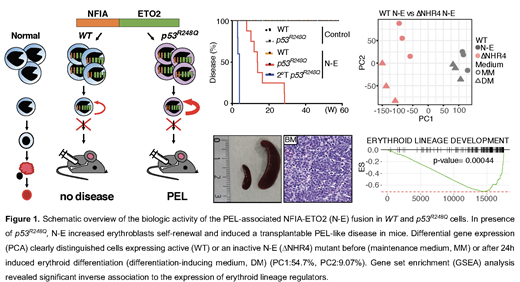Pure erythroleukemia (PEL) is a very aggressive, but poorly understood form of acute myeloid leukemia characterized by malignant accumulation of erythroid progenitor cells. A novel t(1;16)(p31;q24) chromosomal translocation leading to expression of a fusion between the nuclear factor I A (NFIA) and the ETO2 transcriptional co-regulator (a.k.a. CBFA2T3 or MTG16) has been identified in pediatric patients with PEL. Based on the function of the fusion partners, we hypothesized that NFIA-ETO2 (N-E) might initiate PEL by interfering with erythroid differentiation.
To investigate its function, we cloned a full-length ORF and retrovirally expressed N-E in primary mouse bone marrow (BM)- and fetal liver (FL)-derived erythroblasts (EB). N-E expression significantly increased proliferation and blocked differentiation of EB. N-E expressing BM-derived hematopoietic stem and progenitor cells (HSPC) could be plated in erythropoietin (EPO)-containing methylcellulose (MC) for up to 3 rounds. Expression of N-E deletion mutants lacking the NFIA DNA-binding, the ETO2 NHR2 or NHR4 (ΔNHR4) transcriptional repression domains were unable to block erythroid differentiation. Notably, interfering with the ETO2-NHR2 oligomerization domain by overexpressing a competing peptide overcame the N-E-mediated differentiation block.
Transplantation of N-E-expressing BM-derived HSPC into irradiated syngenic mice did not induce any disease suggesting the need of genetic cooperation. As TP53 gain-of-function (GOF) mutations are molecular hallmarks of PEL, we explored functional cooperation by using a conditional TP53R248Q allele. Interestingly, the TP53 status did not affect EB in vitro proliferation or differentiation. However, N-E expression increased proliferation of TP53R248Q+ EB and resulted in the formation of abnormal round and dense colonies in MC that could be serially propagated. In addition, transplantation of N-E-expressing TP53R248Q+ EB into irradiated recipients induced a transplantable PEL-like disease after a median latency of 4 months. Symptomatic mice presented with anemia, thrombocytopenia, multi-organ tumor cell infiltration and increased white blood cell counts. To better understand the molecular mechanism, we compared the gene expression signatures before and 24 hours after induced differentiation of FL-derived EB expressing WT or the inactive ΔNHR4 N-E mutant, in presence or absence of TP53R248Q. Principal component analysis (PCA) revealed a clear separation between the transcriptomes of WT EB expressing either the active or the inactive ΔNHR4 N-E (PC1:54.7%) and by their erythroid differentiation stage (PC2:9.07%). Overall, we observed 3753 (FDR<0.05, logFC>1.5) differentially expressed genes. Many of the significantly higher expressed genes (2313/3753) were related to hematopoietic stemness (GSEAs, p<0.001). Almost 10% of the significantly lower expressed genes (92/1440) were linked to the erythroid lineage development and to erythropoietic targets of NFIA or the erythroid master regulator GATA1. Interestingly, we also found reduced expression of genes encoding for ETO2-interacting transcription factors including TAL1 and KLF1. Despite a critical role on disease progression, PCA showed only minimal changes in the N-E expression signature in presence or absence of TP53R248Q with only 12 genes differently expressed (FDR<0.05, logFC>1). These genes were previously shown to be oncogenic mediators of TP53-GOF mutations, related to metabolism and transcriptional regulation. Interestingly, the signature of differentially expressed genes in N-E transformed FL-derived EB were significantly differentially expressed in tumor cells from pediatric but not adult PEL patients (p=0.00045), indicating the pediatric origin of the fusion.
Collectively, we found that the PEL-associated N-E fusion blocks erythroid differentiation, and cooperates with a TP53-GOF mutation to induce a PEL-like disease in mice that phenocopies the human disease. Mechanistically, its activity seems to correlate with repression of erythroid regulatory genes controlled by the fusion partners NFIA, ETO2, and the erythroid master regulator GATA1.
No relevant conflicts of interest to declare.
Author notes
Asterisk with author names denotes non-ASH members.


This feature is available to Subscribers Only
Sign In or Create an Account Close Modal